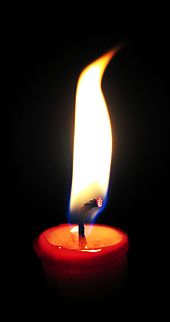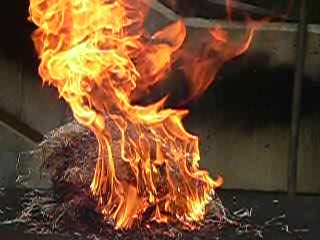Journey Through Time
WHO’S SETTING FIRE TO MACEDONIAN CHURCHES?
Translated by Vesna Stevkovska
Macedonian people - regardless of which part of Macedonia they came from and established a home in the countries across the oceans and in other European countries, as well as other distant parts of the world - represent an inseparably significant part of the entire mosaic of Macedonian truth. The bond that the Macedonians in the Diaspora maintain with their native land, Macedonia, is constant, sincere, humane, nostalgic, and Macedonian. The bridges they build between the Republic of Macedonia and their second homeland are two-way, fruitful, open, and very important in the overall life and work between the people and the countries.

By all means, the Macedonian churches and church communities in the Diaspora are among the most significant, long lasting and many sided nurturers and maintainers of the Macedonian spiritual wealth of Macedonian tradition, of the cultural and historical heritage, and of all that is Macedonian.
The church - as the most significant, and in many ways characteristic institution of the Macedonians in the Diaspora - fulfills a very noble spiritual and national mission. This is especially emphasized in the countries across the ocean and the European countries, where the church has a special role and significance in the Macedonian communities. The national and religious is maintained with great passion, and the life of the Macedonian language, tradition, customs, and folklore is nurtured at these all-Macedonian centres. However, recently we have been witness to misunderstandings within the Macedonian orthodox churches in the Diaspora. A proverb says: “You need two, for both love and argument.” Poor relations between the priests and the peaceful escalated the most in Australia. As if the mutual accusations of the church people and emigrants were not enough, and of the most recent “guests” from Macedonia who - after coming back - spread lies, slander, and accusations against the Macedonians, who neglected their families in order to invest time and means into the construction of the Macedonian orthodox churches.
This bad state of things, the misunderstandings, stubbornness, disrespect of the accomplished, led to disputes and division among the clergy and the believers. They forgot that the Macedonians on the Fifth Continent are Australians of Macedonian descent and that they live by different regulations than those which apply in Macedonia. Their sense of the national is stronger than that of the religious. They forgot that the churches are not simply places where God’s word is heard, where unfortunately there is no church literature in the churches, but that in order to be sustainable they need to have church halls and other buildings which would provide for expenses. Therefore, they are not just religious structures, but centres of communication among the Macedonians, centres for gathering and expressing all that is Macedonian. Unfortunately, the gap between the two groups continues getting deeper. On the one hand, the bishop and his priests strongly supported the canons of the Middle Ages, forgetting that the third millennium needs progress. On the other hand, the Macedonians - a large group of builders and guards of the church and national work on the Fifth Continent - accepted the new living conditions and opposed the ridiculous attempts for usurpation of church properties. Unfortunately, instead of everyone - they, and all who contributed to the overall Macedonian accomplishment - being rewarded, all that happened was anathema, courts, police interventions, hatred among people, and finally, destruction of all that had taken decades to build. Of course, we need to emphasize that the believers are not inviolable either, and they need to respect the constitution of the MOC. Unfortunately, this did not happen. Instead, the St. George and Holy Virgin Mary church in Melbourne was burnt down. The spiritual successor of the first and oldest Macedonian orthodox church in the Diaspora, which represented a foundation stone and motivation for construction of other Macedonian churches in the Diaspora, was destroyed in the fire.
Burning of Macedonian orthodox churches and spiritual shrines in the Diaspora did not start on the 21 October this year, with the destruction of the St. George and Holy Virgin Mary church in Epping. This kind of vandal, anti-church, non-humane act, first happened in Windsor, Canada, when the St. Nicholas church was set on fire in 1980. A similar fate was later shared by the churches of St. Cyril and Methodius in Passaic, New Jersey; St. Naum of Ohrid in Malme, Sweden; St. Nicholas, in the Melbourne suburb of Preston; and the St. Elia church in Mississauga, Canada. This is why the Macedonians are rightfully asking themselves - who is burning the Macedonian churches in the Diaspora?
 A certain number of burnt down churches remained mute witnesses
of the bad relations of the Macedonians among each other and
with the emigrants of the neighbouring countries. Hence, the
Balkan syndrome has been transferred to the Diaspora. Lacking
arguments and evidence, many people are being accused. However,
we will let the authorities and those responsible, solve this.
A certain number of burnt down churches remained mute witnesses
of the bad relations of the Macedonians among each other and
with the emigrants of the neighbouring countries. Hence, the
Balkan syndrome has been transferred to the Diaspora. Lacking
arguments and evidence, many people are being accused. However,
we will let the authorities and those responsible, solve this.
The Macedonian churches in the Diaspora, which were destroyed in fires, were soon restored and new buildings were built. The same will happen with the St. George and Holy Virgin Mary church, and soon it will shine like a true Macedonian architectural achievement. This shows that the Macedonian in the Diaspora knows how to be happy, how to be sad, how to lose, and he knows how to win.
It shows that the Macedonian has always had to fight battles - in his native land and in the Diaspora - to survive and to retain his national identity. His love, faith, and hope for Macedonia and the church, is much stronger, more emphasized and sublime particularly among the Macedonians in the countries across the ocean and in other countries of Europe. In the Diaspora, the spiritual link between the Macedonian migrants - as foreigners, removed from their birthplace, or in most recent times, linked through their intellectual connections - is especially emphasized. There, far away from Macedonia, the love for the native land is tremendous, and it is expressed through the national features, tradition, church customs and rituals, through nurturing of the mother tongue and its holy images, through sport, through song and dance. With all of these characteristics, the Macedonian has survived, and will survive, for as long as the world keeps turning, and the Sun keeps shining.